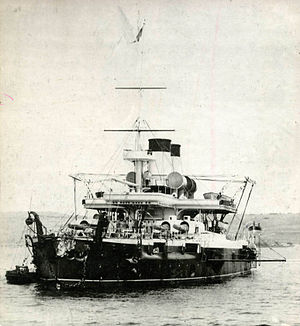Ekaterina II-class battleship

Chesma, showing both forward barbettes
|
|
| Class overview | |
|---|---|
| Name: | Ekaterina II class |
| Builders: | |
| Operators: |
|
| Succeeded by: | Imperator Aleksandr II class |
| Subclasses: | Georgii Pobedonosets |
| Built: | 1883–94 |
| In commission: | 1889–1919 |
| Completed: | 4 |
| Retired: | 4 |
| General characteristics | |
| Type: | Battleship |
| Displacement: | 11,050–11,396 long tons (11,227–11,579 t) |
| Length: | 339 ft 3 in (103.40 m) |
| Beam: | 68 ft 11 in (21.01 m) |
| Draft: | 27.92–28.83 ft (8.51–8.79 m) |
| Installed power: | 9,000 ihp (6,711 kW) |
| Propulsion: |
|
| Speed: | 15–16.5 knots (27.8–30.6 km/h; 17.3–19.0 mph) |
| Range: | 2,800 nautical miles (5,186 km; 3,222 mi) at 10 knots (19 km/h; 12 mph) or 1,367 nautical miles (2,532 km; 1,573 mi) at 14.5 knots (26.9 km/h; 16.7 mph) |
| Complement: | 633–642 |
| Armament: |
|
| Armor: |
|
The Ekaterina II class were a class of four battleships built for the Imperial Russian Navy in the 1880s. They were the first battleships built for the Black Sea Fleet. Their design was highly unusual in having the main guns on three barbettes grouped in a triangle around a central armored redoubt, two side-by-side forward and one on the centerline aft. This was intended to maximize their firepower forward, both when operating in the narrow waters of the Bosphorus and when ramming. Construction was slow because they were the largest warships built until then in the Black Sea and the shipyards had to be upgraded to handle them.
All four ships were in Sevastopol when the crew of the battleship Potemkin mutinied in June 1905.Ekaterina II's crew was considered unreliable and she was disabled to prevent her from joining the mutiny. Chesma's crew was also considered unreliable, but she did escort Potemkin as Sinop towed her back to Sevastopol from Constanța, Romania, where Potemkin's crew had sought asylum. Sinop and Georgii Pobedonosets both pursued Potemkin to Odessa, but the crew of the latter mutinied themselves in sympathy with the crew of the Potemkin. However loyal members of the crew regained control of the ship the next day and grounded her.
A number of proposals were made in the 1900s to reconstruct them and replace their obsolete armor and guns, but none of these were carried out. Ekaterina II and Chesma were both eventually sunk as target ships after being decommissioned in 1907, but both Sinop and Georgii Pobedonosets were converted into artillery training ships before becoming guardships at Sevastopol before World War I. There they spent most of the war and were captured by the Germans in 1918, who eventually turned them over to the British who sabotaged their engines when they abandoned the Crimea in 1919. Immobile they were captured by both the Whites and the Bolsheviks during the Russian Civil War. Sinop was abandoned when Wrangel's fleet sailed for Bizerte, but Georgii Pobedonosets was towed there. Sinop was scrapped beginning in 1922 by the Soviets while Georgii Pobedonosets was eventually scrapped in Bizerte beginning in 1930 by the French.
...
Wikipedia
